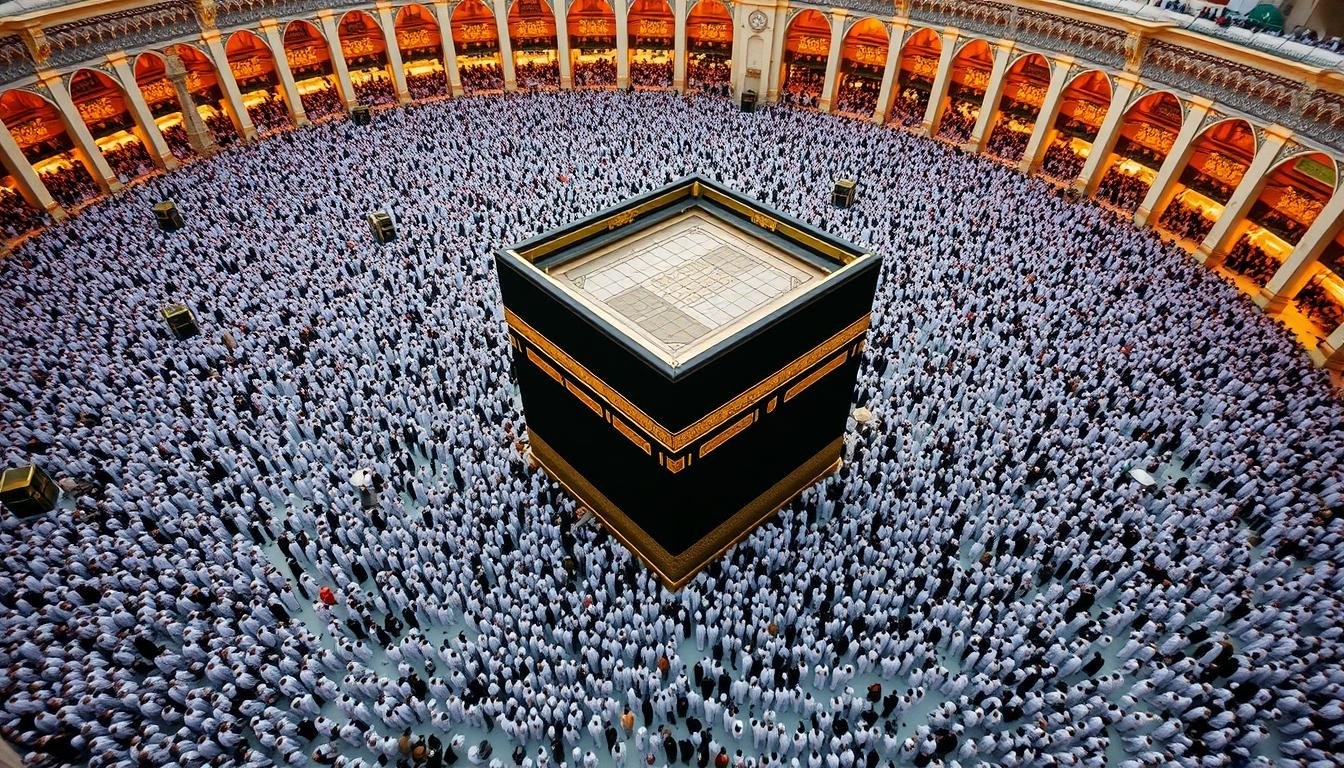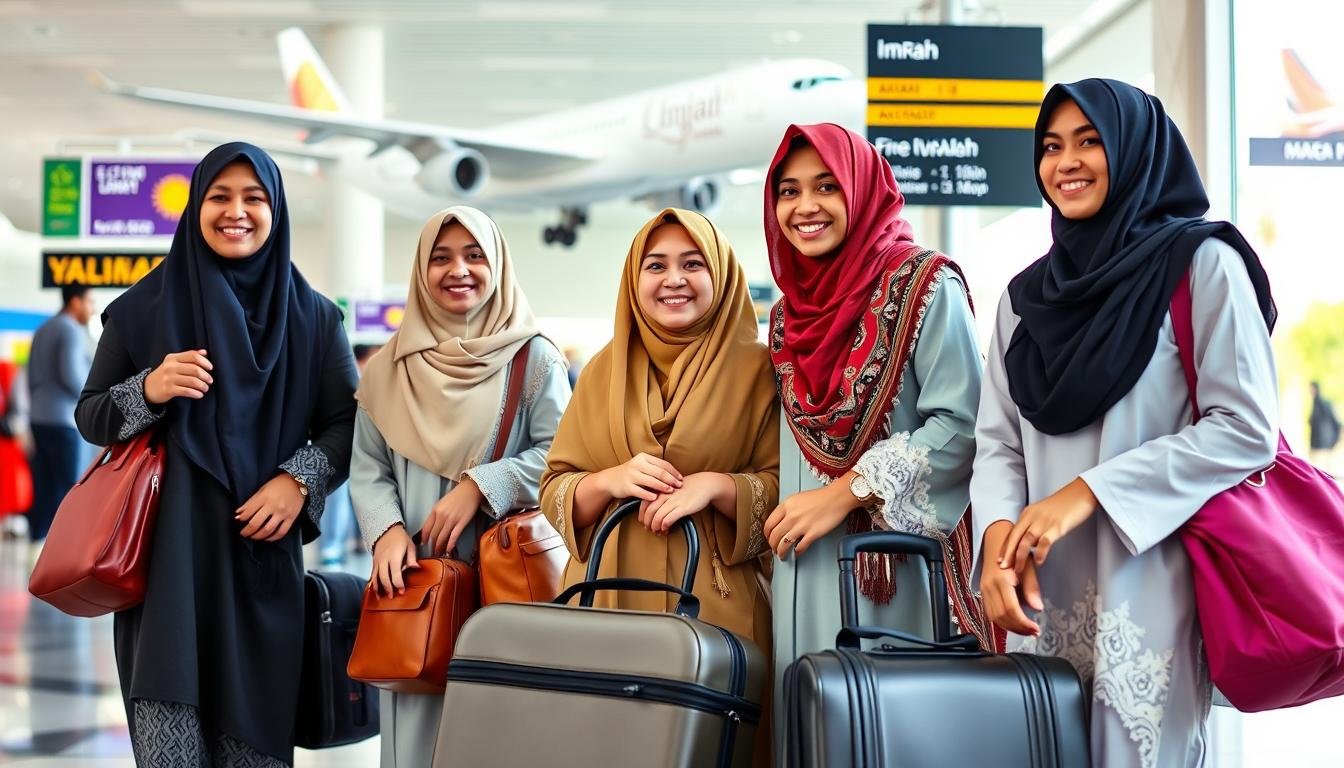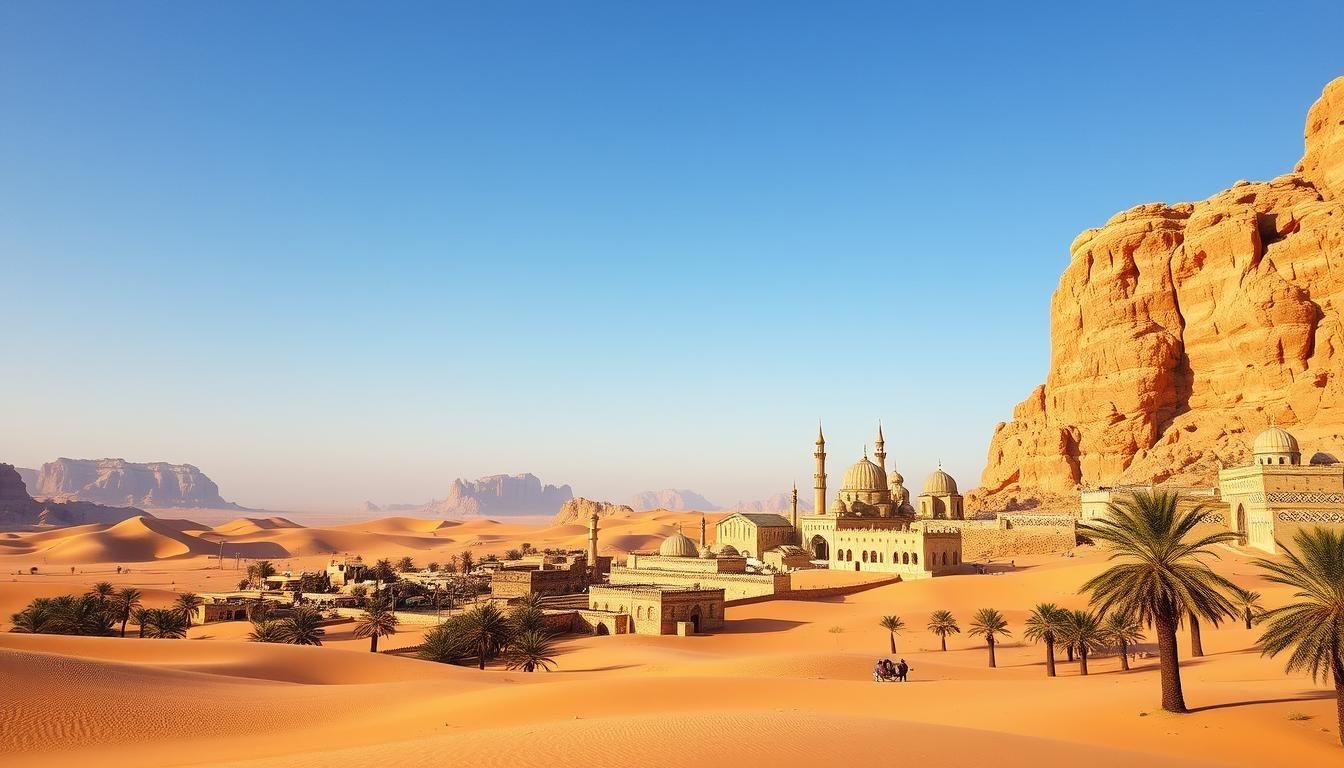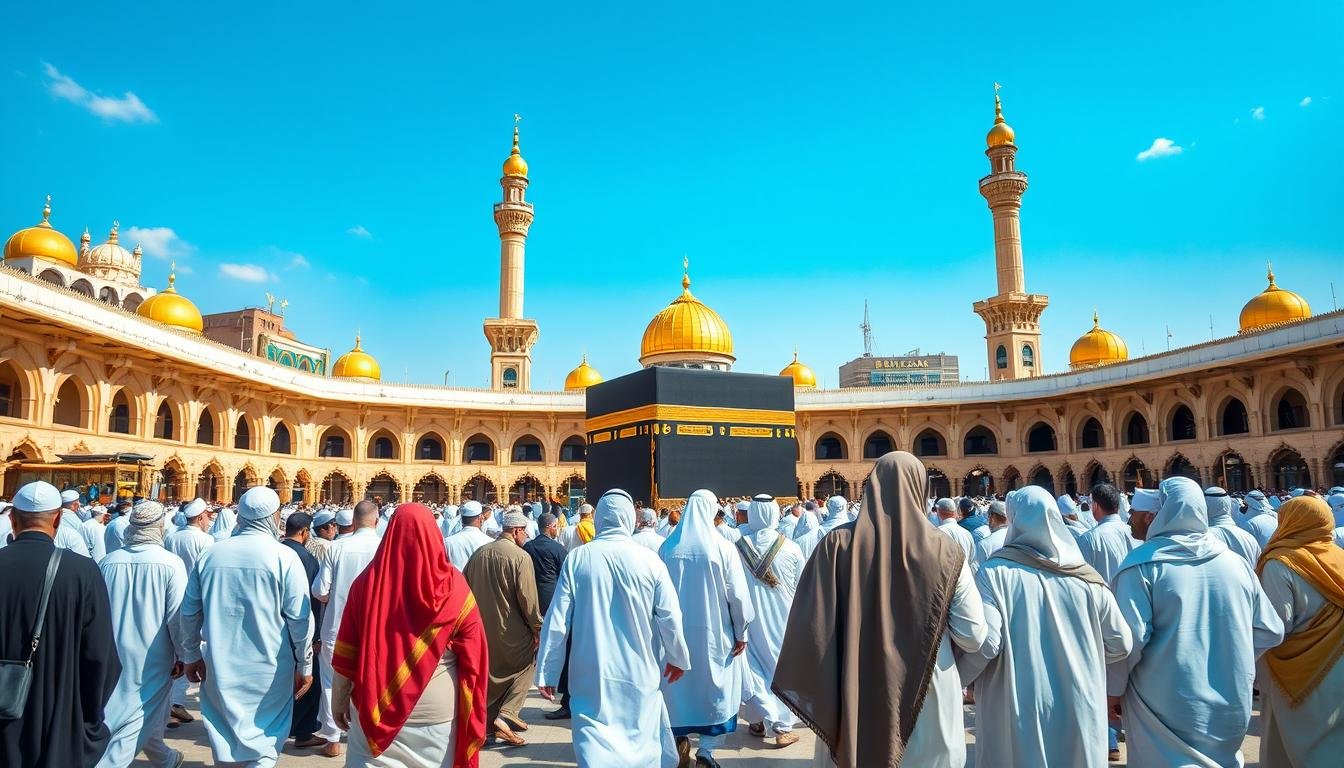As a devout Muslim, I’ve always been drawn to Saudi Arabia’s spiritual legacy. This land, seen as Islam’s birthplace, is filled with sacred sites. These places attract pilgrims and history lovers from all over.
But have you ever thought about which sites are the most important for deepening your faith?
In this guide, we’ll explore Saudi Arabia’s most iconic and historically significant Islamic sites. We’ll visit the famous cities of Makkah and Madinah. We’ll also discover lesser-known spiritual havens.
This article is your ultimate guide to ziyarat (visitation) in Saudi Arabia. Let’s dive into the sacred Islamic heritage that defines this country.
Understanding the Significance of Islamic Pilgrimage in Saudi Arabia
Saudi Arabia is very important in Islam because it has the two holiest sites: Makkah and Madinah. For centuries, Muslims have gone on a journey called ziyarat. This journey goes back to the time of Prophet Muhammad (peace be upon him).
Historical Evolution of Ziyarat Practices
Ziyarat has changed over time. People from all over the world come to Saudi Arabia. They do this to fulfill their religious duties and connect with their faith’s history.
Religious Importance in Islamic Tradition
The Hajj, or pilgrimage to Makkah, is a key part of Islam. Every year, millions of Muslims go to Saudi Arabia. They seek spiritual growth and visit the Kaaba, the holiest site in Islam.
But ziyarat is not just about the Hajj. It also includes visiting the Prophet’s Mosque in Madinah. This shows how important these places are to believers.
Cultural Impact on Muslim Communities
Going on a pilgrimage to Saudi Arabia changes Muslim communities. The journey, rituals, and connection to Islamic heritage bring people together. It strengthens the bonds between Muslims worldwide.
This makes Saudi Arabia a key place for Islamic pilgrimage destinations and spiritual travel in Saudi Arabia.
| Key Aspects of Islamic Pilgrimage in Saudi Arabia | Description |
|---|---|
| Historical Evolution | Tracing the origins and development of ziyarat practices in the region over the centuries |
| Religious Significance | The central role of Makkah, Madinah, and other sacred sites in the Islamic faith |
| Cultural Impact | The profound influence of these pilgrimages on the identity and unity of Muslim communities worldwide |
The Holy Cities of Makkah and Madinah: Primary Destinations
Saudi Arabia is home to the two most sacred sites in the Islamic faith – Makkah and Madinah. These cities are very important for Muslims everywhere. They are the main places for spiritual pilgrimages and visits.
Makkah, also known as the “Mother of Cities,” is where the Prophet Muhammad (peace be upon him) was born. It is also where the Masjid al-Haram is located. This mosque houses the Kaaba, the holiest site in Islam. Every year, millions of Muslims go to Makkah for the Hajj and Umrah pilgrimages.
Madinah is special because it is where the Prophet Muhammad (peace be upon him) started the first Islamic state. It is also where he is buried. The Masjid an-Nabawi, or the Prophet’s Mosque, is the second-holiest site in Islam. It attracts many religious tourists.
| City | Significance | Key Landmarks |
|---|---|---|
| Makkah | Birthplace of Prophet Muhammad (peace be upon him) and home to the Kaaba, the most sacred site in Islam. | Masjid al-Haram, Kaaba, Safa and Marwah Hills |
| Madinah | City where Prophet Muhammad (peace be upon him) established the first Islamic state and his final resting place. | Masjid an-Nabawi, Quba Mosque, Mount Uhud |
Visiting these holy sites in Saudi Arabia is a deep spiritual experience for Muslims. It lets them connect with their faith’s roots and honor the Prophet Muhammad (peace be upon him).
Top Ziyarat Sites in Saudi Arabia for Islamic History Enthusiasts
Saudi Arabia is filled with historical and religious sites important for Islamic history fans. These sites include ancient mosques and sacred battlegrounds. They give a glimpse into the country’s role in the Muslim faith’s growth.
Ancient Mosques and Prayer Sites
The Al-Qiblatain Mosque in Medina is a top spot for Islamic history lovers. It’s famous because the Prophet Muhammad was told to change prayer direction from Jerusalem to Mecca here. Its architecture and role in Islamic tradition make it special.
Historical Battlefields of Islamic Significance
Uhud Mountain, near Medina, is key in Islamic history. It’s where early Muslims fought the Quraysh tribe. This battle shows the struggles and sacrifices that shaped Islam.
Sacred Mountains and Valleys
- Mount Arafat, near Mecca, is where the Prophet Muhammad gave his final sermon. Millions of pilgrims go there for the Hajj.
- The Mina Valley, between Mecca and Mina, is where pilgrims stone the devil during the Hajj.
- Jabal al-Nour, where the Prophet Muhammad first received Quran revelations, is a place for spiritual reflection.
These sites in Saudi Arabia connect visitors to Islam’s rich history and religious importance. They are essential for anyone interested in Islamic history.
| Ziyarat Site | Historical Significance | Religious Importance |
|---|---|---|
| Al-Qiblatain Mosque | Site where the direction of prayer was changed from Jerusalem to Mecca | Symbolic of the unity and centrality of Mecca in Islamic faith |
| Uhud Mountain | Site of a pivotal battle between the early Muslims and the Quraysh tribe | Commemorates the sacrifices and struggles that shaped the foundations of Islam |
| Mount Arafat | Site of the Prophet Muhammad’s final sermon during the Hajj | Considered the climax of the Hajj pilgrimage, where Muslims seek forgiveness and spiritual renewal |
Essential Guide to Visiting Masjid Al-Haram
The Masjid Al-Haram is in the heart of Makkah. It’s the holiest site in Islam. The Kaaba, the most sacred structure, is here. Millions of Muslim pilgrims visit every year.
Visiting Masjid Al-Haram is a deep spiritual experience. Knowing its history, architecture, and rituals makes the journey better. This guide will help you before you visit this iconic site.
Architectural Marvels and Sacred Spaces
The Masjid Al-Haram is an amazing architectural wonder. It combines traditional Islamic design with modern features. The Kaaba, a cube-shaped structure, is the mosque’s centerpiece. It’s covered in a black cloth with Quranic verses.
There are many prayer halls, courtyards, and plazas around the Kaaba. Each has its own importance and rituals. Knowing the key areas and their significance is crucial before you go.
Rituals and Practices for Pilgrims
A visit to Masjid Al-Haram includes many rituals. These rituals are deeply rooted in Islam. They include the Tawaf (circling the Kaaba) and the Sa’i (walking between Safa and Marwah).
Learning the proper etiquette for these rituals is important. It makes your visit meaningful and respectful.
Practical Tips for Visiting
- Visit during off-peak hours to avoid crowds and have a peaceful experience.
- Know the mosque’s layout and key areas to navigate easily.
- Dress modestly and respectfully, following the dress code for men and women.
- Be aware of your surroundings and follow the mosque’s staff and security.
By diving into Masjid Al-Haram’s rich history and traditions, you can deepen your faith. This makes your pilgrimage in Makkah truly transformative.
Exploring the Prophet’s Mosque in Madinah
In the heart of Madinah, the second holiest city in Islam, stands the magnificent Prophet’s Mosque. It’s a testament to the rich history and architecture of Islam. This sacred site is important for Muslims everywhere. It was the first mosque built by Prophet Muhammad (peace be upon him).
Architectural Marvel and Sacred Spaces
The Prophet’s Mosque, also known as Masjid al-Nabawi, is a mix of architectural styles. It has iconic green-domed structures and intricate calligraphic inscriptions. Every inch of this revered sanctuary shows the deep Islamic heritage it holds. Visitors can explore the Rawdah, a hallowed area believed to be between the Prophet’s pulpit and his resting place.
Visiting Protocol and Best Times
Visiting the Prophet’s Mosque in Madinah requires following specific protocols and etiquette. Proper attire, with both men and women covering their heads and bodies, is essential. The best times to visit are during the five daily prayer times. This is when the mosque is filled with the faithful engaged in devotional rituals and serene contemplation.
Nearby Historical Sites
The Prophet’s Mosque is not the only historical marvel in Madinah. The city is full of Islamic heritage sites that complement the spiritual journey. Visitors can explore the nearby Uhud Mountain, the site of a significant battle in Islamic history. Or they can venture to the Quba Mosque, the first mosque built in the Islamic world. These sacred locations offer a deeper understanding of the formative years of the Muslim community and the legacy of Prophet Muhammad.
Lesser-Known Sacred Sites Beyond the Two Holy Mosques
Makkah and Madinah are key spots for Islamic pilgrimage in Saudi Arabia. But, the kingdom has many other important religious places. These sites show the rich culture of the area.
The Masmak Fortress in Riyadh is a historical gem. It was key in uniting the Kingdom of Saudi Arabia. This old mud-brick castle from the late 19th century shows the country’s architecture and its journey.
Jabal al-Nour, or the “Mountain of Light,” is near Makkah. It’s where the Prophet Muhammad got his first Quran revelation. This makes it a sacred place for Muslims all over the world.
| Significant Religious Places | Historical Significance | Reasons for Visiting |
|---|---|---|
| Masmak Fortress, Riyadh | Played a pivotal role in the unification of the Kingdom of Saudi Arabia | Witness the country’s architectural heritage and political history |
| Jabal al-Nour, near Makkah | Site where the Prophet Muhammad received the first revelation of the Quran | Profound spiritual significance for Muslims, opportunity to connect with Islamic history |
These sites let visitors explore Saudi Arabia’s Islamic heritage. They show the country’s cultural and religious diversity. By seeing these shrines and landmarks, travelers can understand the region’s deep spiritual meaning and Islam’s lasting impact.

Practical Tips for Religious Tourism in Saudi Arabia
Traveling to Saudi Arabia’s holy sites requires preparation. You need to know about visas and cultural rules. These tips will make your trip smooth and meaningful.
Visa Requirements and Documentation
Getting the right visa is the first step. Saudi Arabia has different visas, like the Umrah visa for pilgrims and the tourist visa for visitors. Make sure to check the requirements and apply early for a hassle-free trip.
Cultural Etiquette and Dress Code
Respecting local customs is key. Women should wear modest clothes that cover their body. Men should also dress conservatively. Following these rules will enhance your experience.
Transportation and Accommodation
Public transport is common in big cities. But, private transport or guided tours are more convenient. There are many places to stay, from hostels to luxury hotels, for religious travelers.
Remember these tips for a great spiritual journey in Saudi Arabia. It’s a place of deep religious significance.
Best Seasons for Spiritual Travel in Saudi Arabia
Saudi Arabia is at the heart of the Islamic world. It offers a unique spiritual travel experience for all faiths. Timing is key when planning your Islamic pilgrimage or ziyarat journey. Here’s a guide to the best seasons to visit Saudi Arabia’s top ziyarat sites and Islamic pilgrimage destinations.
The two holiest months, Ramadan and Dhul-Hijjah, are the most popular for spiritual travel in Saudi Arabia. In Ramadan, people go to Makkah and Madinah for Umrah. They seek the spiritual energy of these sacred cities.
- Ramadan (9th month of the Islamic calendar): This month of fasting and reflection is unique. The holy sites of Saudi Arabia are filled with devotion, even with large crowds.
- Dhul-Hijjah (12th month of the Islamic calendar): This month is for the Hajj pilgrimage. It’s a time of deep reverence and devotion. You can witness the annual Hajj rituals and feel the spiritual fervor.
Spring and fall are great for visiting, with better weather and fewer crowds. These seasons are perfect for exploring ancient mosques, historical battlefields, and sacred mountains in Saudi Arabia.
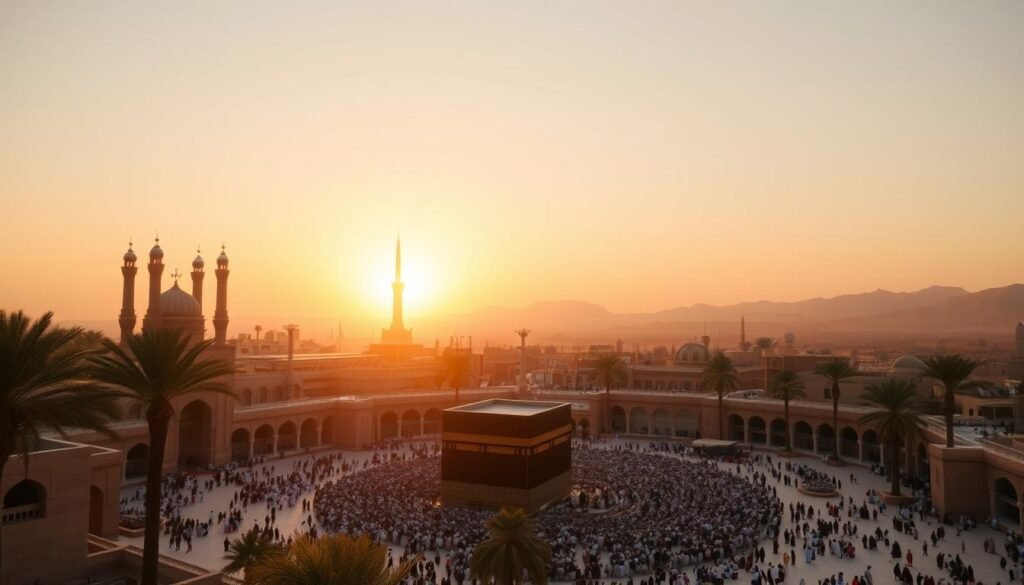
Choosing any time for your spiritual journey in Saudi Arabia is rewarding. You’ll connect with the Islamic faith and experience the region’s rich culture. It’s a transformative experience.
Preserving Islamic Heritage: Saudi Arabia’s Conservation Efforts
Saudi Arabia values its Islamic heritage sites a lot. Recently, the Kingdom has worked hard to keep these treasures safe. It’s focused on ancient mosques and sacred valleys, showing great dedication to its cultural legacy.
Restoration Projects
The restoration of historical mosques is a big effort in Saudi Arabia. The government has put a lot of money into making these mosques look as good as new. This work helps them stay important symbols of Islamic faith and identity.
Projects like fixing the Masjid al-Haram in Makkah and the Prophet’s Mosque in Madinah are key. They show Saudi Arabia’s strong commitment to its religious sites.
Modern Development vs. Historical Preservation
As Saudi Arabia grows, balancing modernization and heritage preservation is tough. The government has worked hard to protect historical sites while also building new things. This way, it can welcome more visitors to these sacred places.
By adding modern features to old traditions, Saudi Arabia has found a good balance. This allows its Islamic heritage to grow, even with all the changes happening around it.
| Restoration Project | Location | Significance |
|---|---|---|
| Masjid al-Haram | Makkah | The holiest site in Islam, home to the Kaaba |
| Prophet’s Mosque | Madinah | The second-holiest site in Islam, where the Prophet Muhammad is buried |
| Al-Masjid al-Nabawi | Madinah | One of the largest and most significant mosques in the world |
Modern Facilities and Services for Religious Tourists
Planning an Islamic pilgrimage to Saudi Arabia’s holy sites is exciting. The Kingdom has built top-notch facilities and services for religious tourists. This includes luxurious places to stay and efficient ways to get around, making my spiritual journey better.
Booking a place to stay near the Masjid al-Haram in Makkah and the Prophet’s Mosque in Madinah is easy. Hotels and resorts for Muslim travelers offer prayer rooms, halal food, and more. Shuttle services and public transport make visiting the holy sites simple.
There’s more to see in Saudi Arabia than just the main pilgrimage sites. I can count on support services for my spiritual travel. Whether it’s help with visas, cultural tips, or advice on what to wear, the local tourism is ready to help.
FAQ
What are the most significant Islamic sites in Saudi Arabia for ziyarat (religious visitation)?
The key sites in Saudi Arabia include Makkah and Madinah. Makkah has the Masjid al-Haram, and Madinah has the Prophet’s Mosque. Other sites include ancient mosques, battlefields, and natural landmarks.
What is the religious and cultural importance of Islamic pilgrimage in Saudi Arabia?
Islamic pilgrimage is very important in Saudi Arabia. It has deep roots in Islamic history. Millions of Muslims visit these sites every year.
Can you describe the key features and historical significance of the holy cities of Makkah and Madinah?
Makkah and Madinah are the holiest cities in Islam. Makkah has the Masjid al-Haram and the Kaaba. Madinah has the Prophet’s Mosque, where the Prophet Muhammad is buried.
What are some of the lesser-known but important ziyarat sites in Saudi Arabia beyond the two holy mosques?
Besides the Masjid al-Haram and the Prophet’s Mosque, there are many other sites. These include ancient mosques, battlefields, and natural landmarks. Each has its own history and significance.
What are the practical considerations for religious tourists visiting Saudi Arabia?
Planning is key for religious tourists in Saudi Arabia. You need to know about visas, dress codes, and where to stay. Understanding the local customs is crucial for a good trip.
What is the best time of year to visit Saudi Arabia for spiritual travel?
The best time to visit depends on the weather and crowds. Spring and fall are usually the best, with mild weather and fewer people.
How is Saudi Arabia preserving its Islamic heritage and promoting conservation efforts?
Saudi Arabia is working hard to keep its Islamic heritage alive. It’s restoring mosques and balancing modernization with preservation. This ensures the landmarks are safe for future generations.
What modern facilities and services are available for religious tourists in Saudi Arabia?
Saudi Arabia has invested in modern facilities for tourists. This includes top-notch places to stay, transport, and support services. It aims to make the journey comfortable and meaningful.
Don’t forget to share your experience in the comments and follow us on social media at the bottom of the site.
